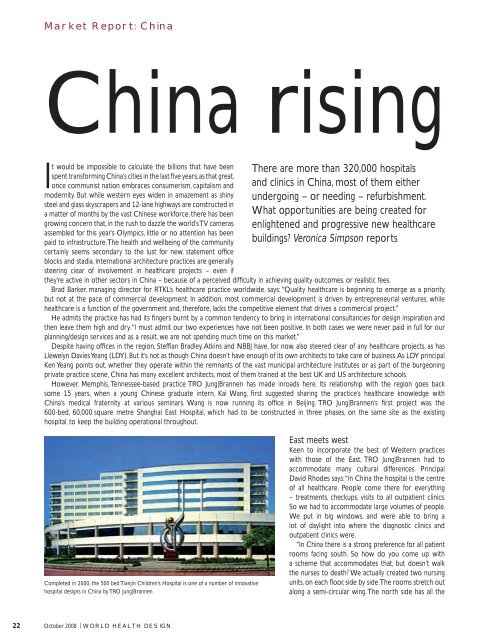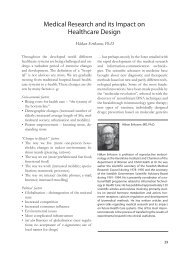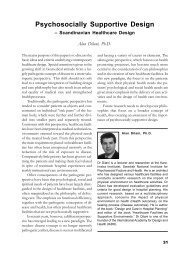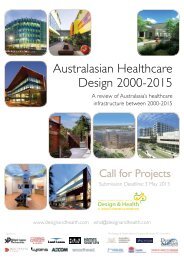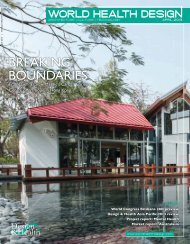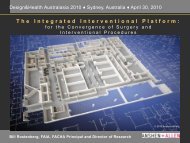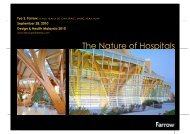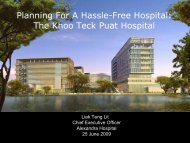SUPER GREEN - the International Academy of Design and Health
SUPER GREEN - the International Academy of Design and Health
SUPER GREEN - the International Academy of Design and Health
- No tags were found...
Create successful ePaper yourself
Turn your PDF publications into a flip-book with our unique Google optimized e-Paper software.
Market Report: ChinaChina risingThere are more than 320,000 hospitals<strong>and</strong> clinics in China, most <strong>of</strong> <strong>the</strong>m ei<strong>the</strong>rundergoing – or needing – refurbishment.What opportunities are being created forenlightened <strong>and</strong> progressive new healthcarebuildings? Veronica Simpson reportsIt would be impossible to calculate <strong>the</strong> billions that have beenspent transforming China’s cities in <strong>the</strong> last fi ve years, as that great,once communist nation embraces consumerism, capitalism <strong>and</strong>modernity. But while western eyes widen in amazement as shinysteel <strong>and</strong> glass skyscrapers <strong>and</strong> 12-lane highways are constructed ina matter <strong>of</strong> months by <strong>the</strong> vast Chinese workforce, <strong>the</strong>re has beengrowing concern that, in <strong>the</strong> rush to dazzle <strong>the</strong> world’s TV camerasassembled for this year’s Olympics, little or no attention has beenpaid to infrastructure. The health <strong>and</strong> wellbeing <strong>of</strong> <strong>the</strong> communitycertainly seems secondary to <strong>the</strong> lust for new, statement <strong>of</strong>fi ceblocks <strong>and</strong> stadia. <strong>International</strong> architecture practices are generallysteering clear <strong>of</strong> involvement in healthcare projects – even if<strong>the</strong>y’re active in o<strong>the</strong>r sectors in China – because <strong>of</strong> a perceived diffi culty in achieving quality outcomes, or realistic fees.Brad Barker, managing director for RTKL’s healthcare practice worldwide, says: “Quality healthcare is beginning to emerge as a priority,but not at <strong>the</strong> pace <strong>of</strong> commercial development. In addition, most commercial development is driven by entrepreneurial ventures, whilehealthcare is a function <strong>of</strong> <strong>the</strong> government <strong>and</strong>, <strong>the</strong>refore, lacks <strong>the</strong> competitive element that drives a commercial project.”He admits <strong>the</strong> practice has had its fi ngers burnt by a common tendency to bring in international consultancies for design inspiration <strong>and</strong><strong>the</strong>n leave <strong>the</strong>m high <strong>and</strong> dry. “I must admit our two experiences have not been positive. In both cases we were never paid in full for ourplanning/design services <strong>and</strong> as a result, we are not spending much time on this market.”Despite having <strong>of</strong>fi ces in <strong>the</strong> region, Steffi an Bradley, Atkins <strong>and</strong> NBBJ have, for now, also steered clear <strong>of</strong> any healthcare projects, as hasLlewelyn Davies Yeang (LDY). But it’s not as though China doesn’t have enough <strong>of</strong> its own architects to take care <strong>of</strong> business. As LDY principalKen Yeang points out, whe<strong>the</strong>r <strong>the</strong>y operate within <strong>the</strong> remnants <strong>of</strong> <strong>the</strong> vast municipal architecture institutes or as part <strong>of</strong> <strong>the</strong> burgeoningprivate practice scene, China has many excellent architects, most <strong>of</strong> <strong>the</strong>m trained at <strong>the</strong> best UK <strong>and</strong> US architecture schools.However, Memphis, Tennessee-based practice TRO Jung|Brannen has made inroads here. Its relationship with <strong>the</strong> region goes backsome 15 years, when a young Chinese graduate intern, Kai Wang, fi rst suggested sharing <strong>the</strong> practice’s healthcare knowledge withChina’s medical fraternity at various seminars. Wang is now running its <strong>of</strong>fi ce in Beijing. TRO Jung|Brannen’s fi rst project was <strong>the</strong>600-bed, 60,000 square metre Shanghai East Hospital, which had to be constructed in three phases, on <strong>the</strong> same site as <strong>the</strong> existinghospital, to keep <strong>the</strong> building operational throughout.Completed in 2000, <strong>the</strong> 500 bed Tianjin Children’s Hospital is one <strong>of</strong> a number <strong>of</strong> innovativehospital designs in China by TRO Jung|BrannenEast meets westKeen to incorporate <strong>the</strong> best <strong>of</strong> Western practiceswith those <strong>of</strong> <strong>the</strong> East, TRO Jung|Brannen had toaccommodate many cultural differences. PrincipalDavid Rhodes says: “In China <strong>the</strong> hospital is <strong>the</strong> centre<strong>of</strong> all healthcare. People come <strong>the</strong>re for everything– treatments, checkups, visits to all outpatient clinics.So we had to accommodate large volumes <strong>of</strong> people.We put in big windows, <strong>and</strong> were able to bring alot <strong>of</strong> daylight into where <strong>the</strong> diagnostic clinics <strong>and</strong>outpatient clinics were.“In China <strong>the</strong>re is a strong preference for all patientrooms facing south. So how do you come up witha scheme that accommodates that, but doesn’t walk<strong>the</strong> nurses to death? We actually created two nursingunits, on each fl oor, side by side. The rooms stretch outalong a semi-circular wing. The north side has all <strong>the</strong>22 October 2008 | WORLD HEALTH DESIGN


